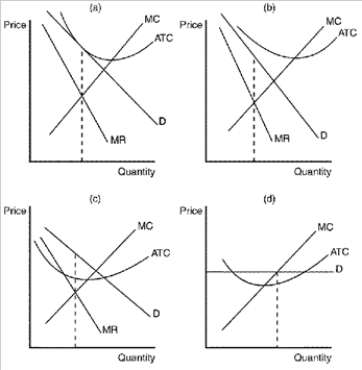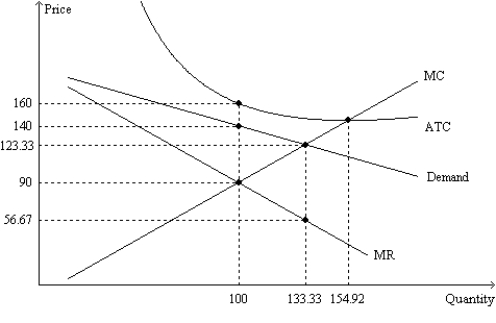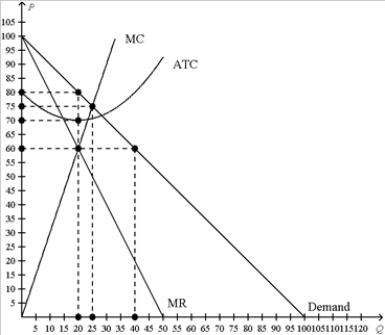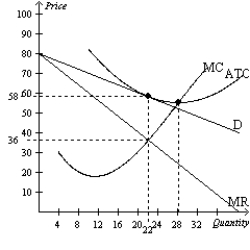Correct Answer

verified
Correct Answer
verified
Multiple Choice
The two types of imperfectly competitive markets are
A) monopoly and monopolistic competition.
B) monopoly and oligopoly.
C) monopolistic competition and oligopoly.
D) monopolistic competition and cartels.
F) None of the above
Correct Answer

verified
Correct Answer
verified
Multiple Choice
Figure 16-5  -Refer to Figure 16-5. Which of the panels shown could illustrate the short-run situation for a monopolistically competitive firm?
-Refer to Figure 16-5. Which of the panels shown could illustrate the short-run situation for a monopolistically competitive firm?
A) panel a
B) panel b
C) panel c
D) All of the above are correct.
F) A) and C)
Correct Answer

verified
Correct Answer
verified
Multiple Choice
Suppose the point of tangency that characterizes long-run equilibrium for a monopolistically competitive firm occurs at Q1 units of output. This level of output, Q1,
A) exceeds the level of output at which marginal revenue equals marginal cost.
B) exceeds the level of output at which marginal cost equals average total cost.
C) falls short of the level of output at which price equals marginal cost.
D) exceeds the firm's efficient scale of output.
F) None of the above
Correct Answer

verified
Correct Answer
verified
Multiple Choice
In the study done by Lee Benham on advertising for eyeglasses,
A) advertising increased the average price.
B) advertising decreased the average price.
C) there was no difference in price, but quality was better in the states that didn't allow advertising.
D) advertising appeared to have no effect whatsoever in the states that permitted advertising.
F) B) and D)
Correct Answer

verified
Correct Answer
verified
Multiple Choice
Figure 16-5  -Refer to Figure 16-5. Which of the graphs depicts a short-run equilibrium that will not encourage either the entry or exit of firms in a monopolistically competitive industry?
-Refer to Figure 16-5. Which of the graphs depicts a short-run equilibrium that will not encourage either the entry or exit of firms in a monopolistically competitive industry?
A) panel a
B) panel b
C) panel c
D) panel d
F) A) and C)
Correct Answer

verified
Correct Answer
verified
Short Answer
Describe the shape of the monopolistically competitive firm's demand curve.
Correct Answer

verified
Correct Answer
verified
Multiple Choice
Which two curves are tangent to each other in a monopolistically competitive market with zero economic profit?
A) demand and average variable cost
B) demand and average total cost
C) marginal revenue and average variable cost
D) marginal revenue and average total cost
F) B) and C)
Correct Answer

verified
Correct Answer
verified
Multiple Choice
Figure 16-10
The figure is drawn for a monopolistically-competitive firm.  -Refer to Figure 16-10. When the firm is maximizing its profit,
-Refer to Figure 16-10. When the firm is maximizing its profit,
A) TR = $9,000 and TC =$16,000.
B) TR = $14,000 and TC =$16,000.
C) TR = $16,000 and TC =$16,000.
D) MC exceeds MR by $66.66 on the last unit of output produced.
F) None of the above
Correct Answer

verified
Correct Answer
verified
Multiple Choice
Which of the following correctly lists the products in order from most advertised to least advertised?
A) soft drinks, breakfast cereals, dog food
B) corn, dog food, communication satellites
C) dog food, communication satellites, corn
D) wheat, corn, crude oil
F) None of the above
Correct Answer

verified
Correct Answer
verified
Multiple Choice
Figure 16-3
This figure depicts a situation in a monopolistically competitive market.  -Refer to Figure 16-3. What price will the monopolistically competitive firm charge in this market?
-Refer to Figure 16-3. What price will the monopolistically competitive firm charge in this market?
A) $60
B) $70
C) $75
D) $80
F) A) and C)
Correct Answer

verified
Correct Answer
verified
Multiple Choice
The theory of monopolistic competition is somewhat disappointing in that it fails to
A) pinpoint a profit-maximizing level of output for monopolistically competitive firms.
B) yield simple and compelling advice for public policy.
C) explain why product differentiation is observed in monopolistically competitive markets.
D) explain why monopolistically competitive firms have excess capacity.
F) A) and D)
Correct Answer

verified
Correct Answer
verified
Short Answer
Figure 16-13  -Refer to Figure 16-13. Use the letters to identify the area of total revenue for this firm.
-Refer to Figure 16-13. Use the letters to identify the area of total revenue for this firm.
Correct Answer

verified
Correct Answer
verified
Multiple Choice
A monopolistically competitive firm chooses the quantity to produce where
A) price equals marginal cost.
B) demand equals marginal cost.
C) marginal revenue equals marginal cost.
D) Both a and c are correct.
F) C) and D)
Correct Answer

verified
Correct Answer
verified
Multiple Choice
Which market structure would likely have the highest concentration ratio?
A) Monopoly
B) Oligopoly
C) Monopolistic competition
D) Perfect competition
F) A) and D)
Correct Answer

verified
Correct Answer
verified
True/False
The claim that advertising reduces the elasticity of demand is likely to be made by a defender of advertising.
B) False
Correct Answer

verified
Correct Answer
verified
Multiple Choice
Which of the following is unique to a monopolistically competitive firm when compared to an oligopoly?
A) The monopolistically competitive firm advertises.
B) The monopolistically competitive firm produces a quantity of output that falls short of the socially optimal level.
C) Monopolistic competition features many buyers.
D) Monopolistic competition features many sellers.
F) None of the above
Correct Answer

verified
Correct Answer
verified
True/False
Policymakers have generally come to accept the view that advertising enhances the efficiency of markets.
B) False
Correct Answer

verified
Correct Answer
verified
True/False
In a long-run equilibrium, both perfectly competitive markets and monopolistically competitive markets have price equal to average total cost.
B) False
Correct Answer

verified
Correct Answer
verified
Short Answer
Figure 16-12  -Refer to Figure 16-12. How much excess capacity does this firm have?
-Refer to Figure 16-12. How much excess capacity does this firm have?
Correct Answer

verified
Correct Answer
verified
Showing 501 - 520 of 580
Related Exams